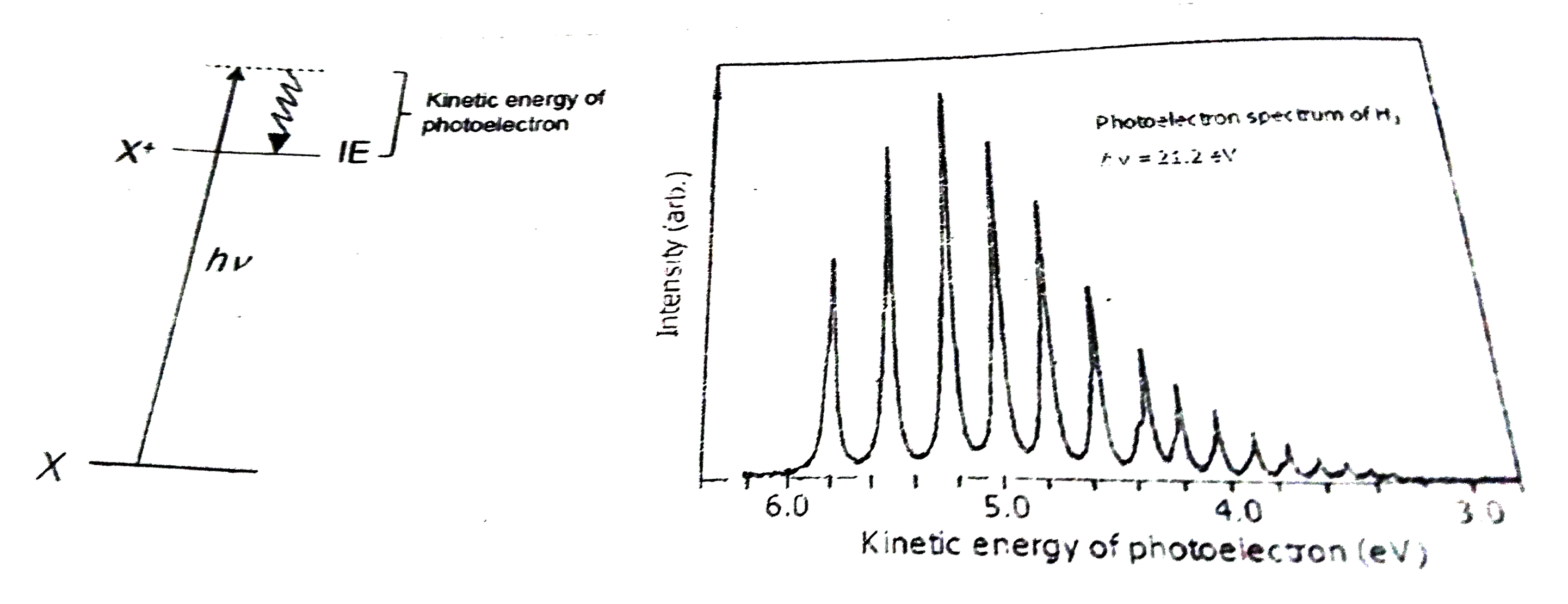When an atom X absorbs radiation with a photon energy than the ionization energy of the atom, the atom is ionized to generate an ion and the electron (called a photoelectron) is ejected at the same time. In this event, the energy is conserved as shown in Figure , that is,
Photon energy (h)=ionization energy (IE) of kinetic energy of photoelectron.
When a molecule, for example, , absorbs short-wavelength light, the photoelectron is ejected and an , ion with a variety of vibrational states is produced. A photoelectron spectrum is a plot of the number of photoelectrons as a function of the kinetic energy of the photoelectrons. Figure-2 shows a typical photoelectron spectrum when in the lowest vibrational level is irradiated by monochromatic light of . No photoelectrons are detected above . (eV is a unit of energy and is equal to )

Figure 1 Schematic diagram of photoelectron spectroscopy.
Figure 2 Photoelectron spectrum of . The energy of the incident light is
Considering an energy cycle, the bond energy of to the first decimal place. If you were unable to determine the values for and , then use and for and , respectively.
The correct Answer is:From Fig. below
Step by step video & image solution for When an atom X absorbs radiation with a photon energy than the ionization energy of the atom, the atom is ionized to generate an ion X^(+) and the electron (called a photoelectron) is ejected at the same time. In this event, the energy is conserved as shown in Figure 1, that is, Photon energy (h)=ionization energy (IE) of X+ kinetic energy of photoelectron. When a molecule, for example, H_(2), absorbs short-wavelength light, the photoelectron is ejected and an H_(2), ion with a variety of vibrational states is produced. A photoelectron spectrum is a plot of the number of photoelectrons as a function of the kinetic energy of the photoelectrons. Figure-2 shows a typical photoelectron spectrum when H_(2) in the lowest vibrational level is irradiated by monochromatic light of 21.2 eV. No photoelectrons are detected above 6.0 eV. (eV is a unit of energy and 1.0 eV is equal to 1.6xx10^(-19) J) Figure 1 Schematic diagram of photoelectron spectroscopy. Figure 2 Photoelectron spectrum of H_(2). The energy of the incident light is 21.2 eV Considering an energy cycle, ul("determine") the bond energy E_(D)( eV) of H_(2)^(+) to the first decimal place. If you were unable to determine the values for E_(B) and E_(C), then use 15.0 eV and 5.0 eV for E_(B) and E_(C), respectively. by Chemistry experts to help you in doubts & scoring excellent marks in Class 12 exams.
Updated on:21/07/2023Similar Questions
When an atom X absorbs radiation with a photon energy than the ionization energy of the atom, the atom is ionized to generate an ion X+ and the electron (called a photoelectron) is ejected at the same time. In this event, the energy is conserved as shown in Figure 1, that is,
Photon energy (h)=ionization energy (IE) of X+ kinetic energy of photoelectron.
When a molecule, for example, H2, absorbs short-wavelength light, the photoelectron is ejected and an H2, ion with a variety of vibrational states is produced. A photoelectron spectrum is a plot of the number of photoelectrons as a function of the kinetic energy of the photoelectrons. Figure-2 shows a typical photoelectron spectrum when H2 in the lowest vibrational level is irradiated by monochromatic light of 21.2eV. No photoelectrons are detected above 6.0eV. (eV is a unit of energy and 1.0eV is equal to 1.6×10−19J)

Figure 1 Schematic diagram of photoelectron spectroscopy.
Figure 2 Photoelectron spectrum of H2. The energy of the incident light is 21.2eV
Determine–––––––––––– the bond energy EC(eV) of H2 to the first decimal place.
View SolutionThe ratio of the third ionization energy of lithium and ionization energy of H atom is of H-atom and that of Li+2 ion is:
View Solution
Knowledge Check
the ionization energy of Li ^(++) is equal to
A9hcRB6 hcRC2hcRDhcR
The ionization energy of H-atom is 13.6eV. Calculate the is ionization energy of Li+2ion-
View SolutionThe ionization energy will be maximum for the process.
View SolutionThe ionization energy will be maximum for the process.
View SolutionIonization energy of He+ ion at minimum energy position is
View SolutionWhy the third ionization energy of manganese (atomic number 25) unexpectedly high?
View SolutionIonization energy is influenced by :
View SolutionIonization energy for hydrogen atom in ergs, Joules and eV respectively is :
View Solution
